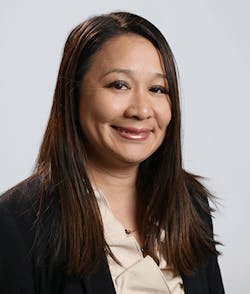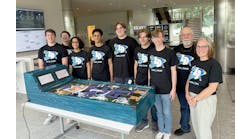Nina Golder is vice president, global lifecycle services, process systems & solutions, Emerson.
According to U.S. census data, the percentage of women in engineering occupations has increased from a mere 3% to 15% over the past 50 years. While the needle is pointed in the right direction, there’s still a lot of room to grow that number. What seem to be the biggest hurdles to women interested in engineering and automation fields? And what difficulties are employers encountering as they work to increase that number?
Nina Golder, vice president, global lifecycle services, process systems & solutions, Emerson: We have a long way to go to move the needle. The obstacles to achieving increased gender parity start before women even get into engineering roles. We need to continue to attract more females into engineering careers, starting with building and sustaining interest at the elementary-school level.
Also read: 5 ways to find success as a woman in STEM
Vice president, global life sciences, process systems & solutions, Emerson.
Once we have females in STEM roles, we must continue to work hard to retain them by fostering supportive environments and investing time and effort in ongoing development of their careers. At Emerson, we are fostering a safe environment to empower and support our female employees by elevating their visibility and inspiring achievement of their career goals through one of our employee resource groups called the Women’s Impact Network.
Organizations must be intentional about the goal to achieve gender parity; Emerson recently released targets around doubling representation of women in leadership positions, with a goal of at least 40% global leadership by women by 2030. Although the concept of targets can create challenging discussions, we cannot close our gender gap without an intentional step change, as well as fostering and creating environmental conditions that will drive the change.
With the skilled labor shortage that began pre-pandemic and was heightened by the shutdown, how can organizations capitalize on the availability of women to fill these roles?
Nina Golder, vice president, global lifecycle services, process systems & solutions, Emerson: The pandemic taught us to accelerate technology adoption and adapt to remote/hybrid/flexible environments. It also presents an opportunity to increase our ability to bring in females who desire or need more flexible work arrangements. The increased flexibility in work options may help to accelerate the increase of females in industry and engineering roles.
But, while a restructured work environment created new opportunities to bring more women into engineering roles, we also need to reverse the current trend of women leaving fields, which was exacerbated by the pandemic. Traditional engineering roles are fairly tied to a physical location, which was particularly hard on female engineers who are parents and caregivers.
I am hopeful that acceptance of more flexible work arrangements can help retain female engineers who are caregivers or parents in the workforce. The operative word here is acceptance; flexible work situations can’t be seen as career stallers or inequitable to fully in-person roles if we want to continue to win the talent war and drive to increase female representation. This again will only be one aspect of the complex challenges associated with driving more representation.
In her relatively famous study, published in the Harvard Business Review, MIT’s Susan Silbey and her colleagues found that women in engineering experienced a significant amount of gender bias not only at the college level, but even more so in internships and co-ops and then when entering the workforce. She estimates that 40% of women who earn an engineering degree either quit or never enter the profession. What can be done to nurture and develop these women, especially early in their careers?
Nina Golder, vice president, global lifecycle services, process systems & solutions, Emerson: There are many offramps where women are pressured to exit engineering careers, and to help women navigate around them we must be able to provide support at different critical junctures from the classroom all the way to the boardroom. The early career is one of the very critical phases where mentoring is essential, and universities and organizations must be intentional about providing support.
I personally faced a moment where I was making a critical decision on whether to take a non-engineering/industry path, and, although I did not ultimately go an alternate route, I didn’t know or have resources at the time to talk through the decision. We need strong mentors, advocates and role models to continue to inspire, coach and support our female employees in the early part of their careers. It is also important to have a personal network that can help women reaffirm their interest in getting into engineering careers, be a sounding board for the challenging times and share and celebrate their wins along the way.
One of the other findings in Silbey’s report is that the women who participated were hoping to make a more socially conscious impact in their engineering pursuits than the males in the study. What, if anything, does this tell us about gender bias? And, if the report is indicative of a real female desire to make a difference, where might women find those types of jobs to have a positive impact on society and civilization with their engineering and automation expertise?
Nina Golder, vice president, global lifecycle services, process systems & solutions, Emerson: There is a new generation of talent emerging that sets a high priority on social impact and purpose. Recognizing and valuing that purpose will be essential to attracting the best talent in the years to come.
Much like this new generation, the companies that will win the future recognize the need for innovation and disruption is greater than ever. At Emerson we have rallied around several causes. Our Roadmap to Industrial Sustainability is helping Emerson and our customers make the critical changes necessary to drive a more sustainable future. We are also focused on driving equity across our organization worldwide with goals of 40% global leadership by women and 30% leadership by minorities in the United States by 2030. We are focused on articulating the value that engineering and automation expertise is bringing to the world and society and know that we can best show that commitment through our own internal initiatives.
We must continue to showcase to women and future generations that engineering and automation expertise can bring significant contribution to society. One great example of this at Emerson is how we were able to use our technology to help Moderna quickly and safely bring vaccines to market during the pandemic. Engineers have been our greatest problem solvers and world changers. Perhaps it is time to rebrand the word engineering—what about “innovationeering”?
According to the latest research from the Society for Women Engineers, females earn 10% less than their male counterparts. How does this impact a woman’s interest in entering an automation-related field, and what can be done to counteract this?
Nina Golder, vice president, global lifecycle services, process systems & solutions, Emerson: The battle for talent is challenging enough; therefore, we in the engineering and automation fields need to eliminate the gender-pay-gap challenge so that we can help ourselves build a larger talent pool—we can’t be missing out on half of the population. Unlike many of the other challenges, which ultimately come down to more personal reasons for women choosing engineering careers or staying in them, the pay gap is a systemic issue that we can resolve if we are deliberate about it through process.
As hiring managers, let’s set budgets based on role/skillset desired and constantly check our own biases throughout our hiring processes. We can also continually check ourselves by performing blind salary reviews and ensure we are removing any bias. In this data-rich world, I would also encourage women to know their worth and feel comfortable negotiating for what their value is.
How can mentoring programs help women to stay the course and feel fulfilled in their automation or engineering pursuits?
Nina Golder, vice president, global lifecycle services, process systems & solutions, Emerson: From the earliest stages, good mentoring is essential. The Women’s Impact Network employee resource group—Emerson’s organizational structure to empower and support our female employees by elevating their visibility and inspiring achievement of their career goals—is a great step, but strong mentoring needs to start earlier than that. Ideally women in STEM should have a strong support foundation from the earliest moments of elementary school all the way through college. This will require a systemic change both in applied resources and in the way we support and foster women who show an interest and aptitude in engineering.
What sorts of initiatives is your company involved with to encourage female participation in the automation field?
Nina Golder, vice president, global lifecycle services, process systems & solutions, Emerson: Emerson has several employee resource groups (ERGs), and one that is encouraging and developing female participation in the automation field is our Women’s Impact Network. The Women’s Impact Network provides support, networking and career-development opportunities for women employees around the globe. In 2021, the 6,000-member group reached a milestone of 100 chapters across the organization.
In addition to the ERG’s growth, the Women’s Impact Network helped push Emerson forward as an organization, by helping to increase the number of women in leadership positions, hosting regular webinars and attracting a new generation of women in STEM to the company through partnerships with the Society of Women Engineers and several universities, as well as focusing on K-12 educational events. At Emerson, we make it a priority to promote STEM education and programs that prepare the next generation of critical thinkers and problem solvers; we must promote awareness at this level to move the needle far beyond where we are today.







